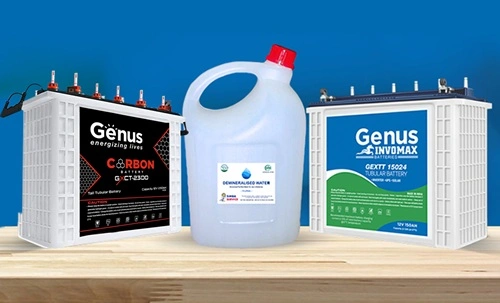In India, powercuts and summer have become the new best friends. It will be scorching 50 degrees outside, and that’s when the a power cut feels it is the right time to test your patience. This is why more and more homes are installing inverters nowadays.
When hunting for an inverter, we often tend to miss that it is actually the inverter batteries that decide how much power you can enjoy and for how long. They’re the boat that keeps the inverter sailing. But not every battery is the same.
Inverter batteries often come in different sizes and capacities, but deciding which one to choose is a different hassle altogether, which is why in this article, we’ll dive deep into inverter battery capacity.

Why Accurate Battery Sizing Matters
“Inverter battery size doesn’t matter” is something a lot of local electricians will tell you. It is one of the biggest myths people tell about inverter batteries.
The key to having backup power that works is selecting the right battery size. An undersized battery might not provide the backup you need in an outage; a battery that is too large may be less efficient and more expensive. You will need to determine how much power inverter you require and choose an inverter battery with the exact amount of power that suits your requirements.
Step 1: Identify Your Total Power Requirement
So first, you need to determine how much power you consume, and how much you would need in case of an outage. For that, draw a table on a piece of paper, and then note down the appliance and the wattage. It should look something like this.
| Appliance | Quantity | Wattage (Each) | Total Wattage |
| Tube Light | 4 | 40W | 160W |
| Ceiling Fan | 3 | 75W | 225W |
| LED TV | 1 | 120W | 120W |
| Wi-Fi Router | 1 | 20W | 20W |
| Total | — | — | 525W |
The number that you get, which, for example, here is 525W, becomes the basis of the upcoming steps that you’re going to take.
Pro tip: Only include appliances you would need to survive in case of an outage, or for work purposes. For example, if you work from home from your PC, add your PC to the list.
Step 2: Decide the Desired Backup Duration
Now, ask yourself, how long does a power cut last here? Well, that is because it is the bread and butter for the battery size. If you live in rural areas, it can be 6-8 hours, while for cities, the number can be 4-6 hours. Let’s have a middle ground and consider it 4 hours. You need a battery that can power all your desired applications for 4 hours until power returns.
So that’s where you multiply the total wattage by the desired hours. So:
| 525W × 4 hours = 2100 Watt-hour |
Note: This represents the total power capacity your battery can store, which it should be able to deliver in a full discharge cycle.
P.S. This is a starting point; this is without taking into account voltage and efficiency.
Step 3: Convert Power Requirement to Battery Capacity
Here comes the fun part: you now convert your total power requirement into battery capacity. Here’s how you do that.
| Battery Capacity (Ah) = Power Requirement (Wh) ÷ (Battery Voltage × Efficiency) |
Keep in mind that most inverter batteries run on 12V, and that they have 80-85% of efficiency only. So if we take the example into account.
| 2100 ÷ (12 × 0.8) = 218.75Ah |
If we round it up to the nearest standard, that makes it 220Ah. This is the battery capacity you should be aiming for. Nothing more, nothing less. This is what will matter to your appliances.
Factors That Influence the Required Capacity
Now, let’s take a look at some factors that influence the required capacity. The table below would explain it a lot better.
| Factor | What It Means | How It Affects Your Battery | What to Choose |
| Power Cut Duration & Frequency | If power goes off often but only for a short time (say, an hour or two), your battery doesn’t need to store too much power. But if you face long outages that last several hours, you’ll need more backup. | The longer inverter batteries run during each outage, the deeper they get discharged. Deep discharges shorten its life, so picking the right size helps it last longer. | – For short, frequent cuts: 120–150Ah battery- For long, occasional cuts: 180–220Ah or higher |
| Appliances You Use | Everyday items like lights and fans use steady power, but things like fridges, pumps, or mixers need a strong jolt of current to start up. | These high-start appliances can put extra load on your inverter and battery. If you plan to run them during outages, go for a slightly bigger battery to handle the extra demand smoothly. | – Add about 10–15% more capacity if you’ll be using heavy-start appliances |
| Local Climate & Battery Type | The weather and environment around you matter too. Hot regions, areas with frequent cuts, or modern apartments all call for different battery technologies. | The right type of battery performs better and lasts longer in your specific conditions. It also saves you from extra maintenance. | – Hot climates: Tubular battery – long life, handles heat well.- Frequent cuts: Flat plate battery – recharges quickly and is affordable.- Urban homes: Lithium battery – compact, long-lasting, zero maintenance. |
Quick Reference Table: Typical Battery Size by Usage
To make it even easier for you, here is a quick reference table that you can follow when buying inverter batteries if the steps mentioned above are a bit too much for you.
| Household Type | Average Load | Desired Backup | Suggested Battery Capacity |
| Small (1BHK) | 250–300W | 2–3 hours | 120–150Ah |
| Medium (2–3BHK) | 400–600W | 3–5 hours | 180–220Ah |
| Large (4BHK & above) | 700–1000W | 4–6 hours | 220–250Ah or dual setup |
Conclusion
With the help of this guide, you’re very well on your way to choosing the perfect battery for your home inverter. This guide ensures that your choice keeps you safe and sound, while also powering your house through the worst of the power cuts.
Santosh Kumar, the author behind IndiasStuffs.com, is passionate about sharing valuable insights on a variety of topics, including lifestyle, technology, and Indian culture.
Page Contents

